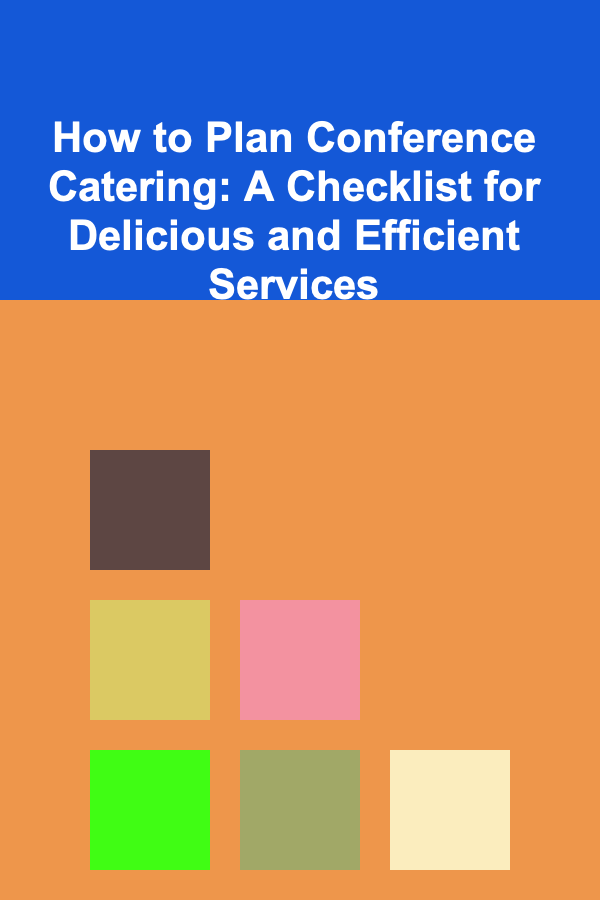
How to Plan Conference Catering: A Checklist for Delicious and Efficient Services
ebook include PDF & Audio bundle (Micro Guide)
$12.99$10.99
Limited Time Offer! Order within the next:

Organizing conference catering requires careful planning, attention to detail, and an understanding of the needs and preferences of the attendees. Whether you are hosting a small professional meeting or a large industry conference, the food and beverages you serve play a pivotal role in the overall experience. Catering not only fuels the attendees but also contributes to the atmosphere, making it an essential aspect of conference planning.
This actionable guide will walk you through the steps of planning conference catering, ensuring you provide delicious, efficient, and memorable service. By following this checklist, you can manage your catering logistics smoothly, enhance guest satisfaction, and stay within budget.
Define Your Catering Goals and Budget
Before diving into the specifics of menu planning or vendor selection, it's essential to define the goals of your catering services. What atmosphere do you want to create? How will the catering complement the conference's overall theme? Understanding these elements will guide your decisions on food offerings, service styles, and budgeting.
Establishing Goals
Ask yourself the following questions:
- What is the conference's tone? Is it formal or informal, corporate or creative?
- How long is the event? A full-day conference will require multiple meals (breakfast, lunch, and possibly dinner), while a half-day event might only need coffee breaks or light snacks.
- Are there specific dietary needs? Conferences often attract a diverse crowd, so you need to plan for dietary restrictions like vegan, vegetarian, gluten-free, or allergen-friendly options.
- What is the level of formality? A formal conference may demand plated meals, while a more casual event could feature buffet-style catering or food stations.
Setting a Budget
Your budget is the backbone of your catering plan. The size of your conference, the location, and the type of food service will all affect the final cost. When determining your catering budget, keep these factors in mind:
- Number of attendees: The more guests, the higher the catering costs. Make sure to include a cushion for unexpected last-minute attendees.
- Catering service: Will you opt for a simple coffee break, or do you plan to serve gourmet meals with multiple courses? The level of service will significantly impact your budget.
- Additional costs: Consider additional charges for rentals (tables, linens, glassware), gratuities, and delivery fees.
Actionable Tip:
Create a detailed budget that includes all possible catering-related costs, including food, service staff, rentals, and extra charges. Allocate a portion of the budget for unexpected expenses, especially if you're working with a third-party caterer who may have hidden costs.
Choose the Right Catering Style
The type of catering you choose will significantly influence the guest experience. There are several catering styles to consider, each with its pros and cons depending on the size and tone of your conference.
Buffet Style
Buffet-style catering is one of the most popular choices for conferences due to its flexibility and variety. Attendees can select their own food, and it works well for large groups.
- Advantages :
- Variety of food options to suit all tastes.
- Self-service allows guests to choose their portions.
- Easy to scale up for large groups.
- Disadvantages :
- Requires more space for setup.
- Can become chaotic during peak times if not managed properly.
- Attendees may take too much food or leave trays empty.
Plated Service
Plated meals are typically used for formal conferences or events that require a more polished approach. The food is served to guests at their seats.
- Advantages :
- Professional and elegant.
- Less chance of food waste since portion sizes are controlled.
- More formal, which may be desirable for high-level meetings or dinners.
- Disadvantages :
- Less variety compared to a buffet.
- More labor-intensive and slower service.
- Higher cost due to staff requirements.
Food Stations
Food stations involve different stations offering specific types of food (e.g., a salad station, sandwich station, or dessert station). This style blends the flexibility of a buffet with the fun of a more interactive catering experience.
- Advantages :
- Interactive experience for attendees.
- Offers variety while minimizing waste.
- Great for networking or social events during the conference.
- Disadvantages :
- Requires careful space planning.
- Can become crowded or chaotic if there are not enough stations or if traffic flow isn't considered.
Boxed Lunches
Boxed lunches are ideal for conferences that involve quick meals or outdoor events. They are pre-packaged and ready to serve, making them convenient for attendees.
- Advantages :
- Efficient for large events.
- Easy to distribute and manage.
- Perfect for grab-and-go meals.
- Disadvantages :
- Less personal or interactive.
- Limited menu options, which may not appeal to all attendees.
Actionable Tip:
Choose the catering style that best aligns with the size of your event, the formality of the conference, and the available budget. If you have a large number of attendees, a buffet or food stations may work best. For smaller, more formal events, a plated meal may be more appropriate.
Plan the Menu
Once you've decided on the catering style, it's time to think about the food itself. The menu should reflect the preferences of your audience, support the theme of the conference, and accommodate any dietary restrictions. Below are some key menu considerations:
Variety and Inclusivity
Offer a wide range of options to cater to various tastes and dietary needs. Ensure that the menu includes:
- Vegetarian, vegan, and gluten-free options.
- Low-sodium and low-sugar alternatives for those with health concerns.
- Allergen-friendly options (e.g., nut-free, dairy-free).
For beverages, consider offering:
- A variety of coffee and tea (decaf and regular).
- Non-alcoholic beverages like fruit-infused water, juices, and sodas.
- If alcohol is allowed, make sure there is a selection of wines, beer, and cocktails that complement the food.
Local or Seasonal Flavors
Incorporating local or seasonal ingredients can add a unique touch to your conference catering. It gives the event a sense of place and highlights regional food specialties.
Actionable Tip:
Create a balanced menu with multiple options for each dietary need. Consider local preferences or regional specialties for an added touch of flavor and authenticity.
Coordinate Logistics and Timeline
Proper logistical planning ensures that the catering service runs smoothly, from food preparation to delivery. A timeline helps to coordinate each step and keeps everything on track.
Timeline for Meal Services
- Breakfast: Plan for breakfast to be available 30--45 minutes before the start of the conference. Breakfast should be light, such as pastries, yogurt, and coffee.
- Coffee Breaks: Schedule coffee breaks between sessions to give attendees a chance to recharge. Typically, a 15--20-minute break works well, with coffee, tea, and light snacks available.
- Lunch: Lunch should be served mid-day, providing enough time for attendees to enjoy a relaxed meal without cutting into key conference sessions. A lunch break of 45 minutes to an hour is ideal.
- Afternoon Snacks: If the conference runs through the afternoon, consider offering a light snack or dessert table to keep attendees energized.
Service Considerations
Work with the caterer to ensure timely delivery and setup:
- Ensure the food arrives on time and stays at the correct temperature (hot foods should remain hot, and cold foods should stay chilled).
- Plan for any additional staff needs, such as servers, cleaners, or bartenders (if alcohol is served).
- Set up food stations or buffets to allow easy flow and minimize waiting times.
Actionable Tip:
Create a detailed catering schedule that outlines all food services, including delivery, setup, and breakdown times. Share this schedule with your catering vendor to avoid any misunderstandings.
Communicate and Coordinate with the Catering Vendor
Finally, establishing clear communication with your catering vendor is crucial for a successful conference. Be specific about your requirements and expectations to avoid last-minute surprises.
- Discuss the Menu: Review the menu options and ask for tastings if possible. Ensure that the caterer understands any dietary restrictions and other special needs.
- Confirm Headcount: Confirm the number of attendees at least a week before the event. It's important to provide an accurate estimate to avoid excess or shortage of food.
- Logistics and Setup: Discuss the layout and any specific requirements for the food service area. Ensure your venue is suitable for catering setup, including power outlets, space for food stations, and access for catering staff.
Actionable Tip:
Schedule a final check-in with your caterer a few days before the event to confirm all details, from the menu to delivery times and any special accommodations.
Conclusion
Planning conference catering can seem like a daunting task, but with thoughtful preparation, it can be a smooth and enjoyable process. By setting clear goals, choosing the right catering style, planning a balanced menu, coordinating logistics, and communicating effectively with vendors, you can ensure your conference catering meets the needs of your attendees while enhancing the overall experience. Remember, good food not only nourishes your guests but also helps create lasting positive impressions that will contribute to the success of your event.
Reading More From Our Other Websites
- [Home Storage Solution 101] How to Store and Organize Your Photography Equipment
- [Home Budget 101] How to Save for Retirement While Sticking to a Home Budget
- [Personal Investment 101] The Top Freelance Opportunities for Deep Learning Professionals
- [Personal Investment 101] How to Use Real Estate Crowdfunding for Small Investors
- [Rock Climbing Tip 101] Mastering the Clip: Essential Techniques for Safe Lead Climbing
- [Horseback Riding Tip 101] How to Choose the Perfect Riding Boots: A Complete Buying Guide
- [Personal Care Tips 101] How to Layer Face Oil with Other Skincare Products
- [Home Party Planning 101] How to Host a Themed Home Party on a Budget
- [Personal Care Tips 101] How to Start a Low-Carb Diet for Weight Loss
- [Personal Care Tips 101] How to Use Sunscreen to Protect Against Wrinkles and Fine Lines

How to Clean Your Windows Like a Pro
Read More
How to Make Money by Offering Deep Learning Services
Read More
How to Make Your Home Feel Bigger Through Staging Techniques
Read More
How to Maximize Small Spaces When Staging My Home
Read More
How to Organize Seasonal Ingredients in Your Recipe Books
Read More
How To Master Time-Lapse Photography
Read MoreOther Products

How to Clean Your Windows Like a Pro
Read More
How to Make Money by Offering Deep Learning Services
Read More
How to Make Your Home Feel Bigger Through Staging Techniques
Read More
How to Maximize Small Spaces When Staging My Home
Read More
How to Organize Seasonal Ingredients in Your Recipe Books
Read More